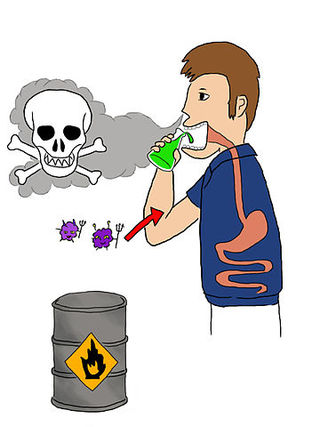Fantasies
The Fantasy of Control and Compartmentalization
Why are we poisoning ourselves?
Posted December 31, 2016
![By Sgt. J.C. McKenzie, USA [Public domain], via Wikimedia Commons By Sgt. J.C. McKenzie, USA [Public domain], via Wikimedia Commons](https://cdn.psychologytoday.com/sites/default/files/styles/image-article_inline_full/public/field_blog_entry_images/ROK_soldiers_with_Chemical_Special_Forces_demonstrate_decontamination_procedures_2009-03-17.jpg?itok=iq-y-P8C)
One of the many illusions of modern life is the pervasive idea that we can isolate and control technologies that industry and the government introduce into the world. Even a cursory examination of the facts reveals this assumption to be pure fantasy.
A prime case in point is synthetic chemicals. About 2,000 new compounds are developed and introduced into new products every year, and something like 100,000 of them are now in circulation globally. They end up in everything from hand sanitizers (e.g. triclosan) to furniture (e.g. organohalogens) to pesticides (e.g. glyphosate) to water bottles (BPA).
Most of these 2,000 new chemicals added to products every year are never or only slightly tested for environmental and human health and safety unless they’re intentionally used in drugs, water, or food (and even then, many questionable chemicals end up in our food supply, e.g. propyl gallate, a preservative for processed food products that contain edible fats).
Forever separate & contained?

The assumption when these chemicals are put into products is that the couch or the water bottle is going to forever be the product it was made to be. But that’s simply not the case. As soon as it’s produced (indeed, during its production) a plastic water bottle, for instance, is already off-gassing or leaching into its environment the chemicals it’s made from. Individual molecules, but also bits and pieces, slough off into the air, water, and soils of the planet, where they can then enter human and other bodies. These products don’t simply stay intact. They erode constantly. And when they’re in direct contact with our skin or we breathe in their particles and gases, these chemicals can become part of us, persisting in our bodies while they alter or disrupt our personal biochemistry.
Scientists in epidemiology and new fields such as exposure science study how we’re exposed to “toxicants” in the environment and what these exposures do to our health. We know, for instance, that chemical flame retardants incorporated into furniture foam (supposedly for our safety—but they’ve more recently been shown to be ineffective) gradually fall out and form dust that gets on our skin and into our lungs. The Green Science Policy Institute, which works tirelessly with industry and government to get these chemicals out of our products, summarizes some of their health effects as they reside in our bodies:
Organohalogen flame retardants have been found to cause adverse reproductive, genotoxic [damaging genetic information in cells, causing mutations], immunotoxic [adversely affecting the functioning of the immune system, perhaps opening us up to infection], neurotoxic [causing nervous system damage or dysfunction], and/or carcinogenic [cancer-causing] outcomes in animal studies. In humans they are associated with reduced IQ (similar to lead poisoning), fertility, birth defects, and hormonal changes. Many are similar in structure or even identical to banned chemicals such as DDT, Mirex, and PCBs. [informational brackets added]
Organohalogen flame retardants are hardly unique as commercial chemicals that hurt humans and the environment. An accounting of all such chemicals and their environmental and health harm can (and has) filled volumes.[1] Some chemicals, such as BPA, found in plastics, are endocrine disrupters and can interfere with our hormonal system. Some of these environmental toxicants made by the chemical industry are even suspected of causing or contributing to obesity; they’re called “obesogens.” The modern chemical scenario is even more disturbing than having thousands of synthetic chemicals that are untested flowing into our environments, causing us untold misery, illness, and death because they can interact with and reinforce each other in our bodies and the environment to become harmful in other ways that are even more difficult to detect.
We all today in the modern world swim in a soup of synthetic chemicals. The new substances the chemical industry creates are perpetually contained in the products we put them in, and they make us sick or kill us. Many lodge in our bodies indefinitely, constituting what scientists have termed our “chemical body burden,” also known as our “toxic body burden.”
Journalists and others have had their toxic body burdens evaluated to discover what products of chemical factories reside inside themselves. Bill Moyers discovered eighty-four distinct contaminants in his body, including dioxins/furans, PCBs, Phthalates, organochlorine pesticides, organophosphate pesticides, and semivolatile and volatile organic compounds: “His test results—much like a chemical fingerprint—revealed evidence of hazardous chemicals in common use—as well as compounds banned for more than a quarter century—and others so obscure that almost no public information is available to identify what products might have resulted in Moyers' exposure. [emphasis added]”
Even polar bears and other wildlife have our toxicants in their bodies, possibly causing them brain damage and other maladies.[2]
In a sense, our principle of manufacture should be something like, “we make it, we eat it” because the stuff we make will eventually get into our bodies just as if we ate it.
Just inject us
The chemicals that companies put into our products get into us just as surely as if those same companies were to inject their toxic products directly into our bodies. Why do we allow this to continue?
One reason surely is the divided up character of our society. Over in some far-off and (for most of us) unimaginable world, engineers (not evil, rather “doing their jobs” making money for themselves and their companies, practicing their professions as taught) are developing these new products in laboratories, and manufacturers are incorporating them into products. Government agencies may or may not regulate the process (in the United States they mostly don’t, held back as they are by anti-regulatory political philosophy—unless chemicals are eaten or injected or intentionally consumed, little testing on them is required even if they are to become ubiquitous in our environments, as has BPA and thousands of other chemicals).
Standards of human justice are tacitly applied to these chemicals—they’re presumed innocent until proven guilty. (In Europe, a different chemical regulatory regime has emerged, based on the “precautionary principle,” in which the onus is on manufacturers to demonstrate the safety of their products.)
But an important point is that all of this is taking place outside our sphere of knowledge and experience, so we go on buying these toxicant-containing products blissfully unaware of how they may be harming us (and polar bears!). In my book Invisible Nature I explain how the divisions shaping modern life—including those between us and nature and us and the products we buy—drive ever onward our harmful choices.
So the compartmentalization that keeps us away from and ignorant of the manufacturing processes we depend on mirrors the compartmentalization we imagine keeps these harmful substances away from us.
One necessary solution is to become more informed and aware participants in the economic transactions we make (buying cosmetics or whatever) so that we may avoid buying the worst contaminants. Fortunately, there are tools available to do so. I urge you to make use of them.
A prime example is the Environmental Working Group’s guides for consumers. They’ve published a guide for avoiding the “dirty dozen” most common and harmful food additives, a guide to safer and healthier cosmetics (did you know they commonly contain various toxic ingredients?), a guide to less toxic cleaning products, and some others. The Good Guide similarly provides ratings for products and allows people to specify the health and environmental criteria most important to them.
Becoming an intentional and conscious consumer is a good first step to joining with others to create a cleaner world.
Check out my book: Invisible Nature
Follow me: Twitter or Facebook
Read more of my posts: The Green Mind
[1] A good introduction is Geiser, Ken. Materials Matter: Toward a Sustainable Materials Policy. Cambridge, Mass.: MIT Press, 2001.
[2] http://www.research.ufl.edu/publications/explore/v10n3/extract8.html




